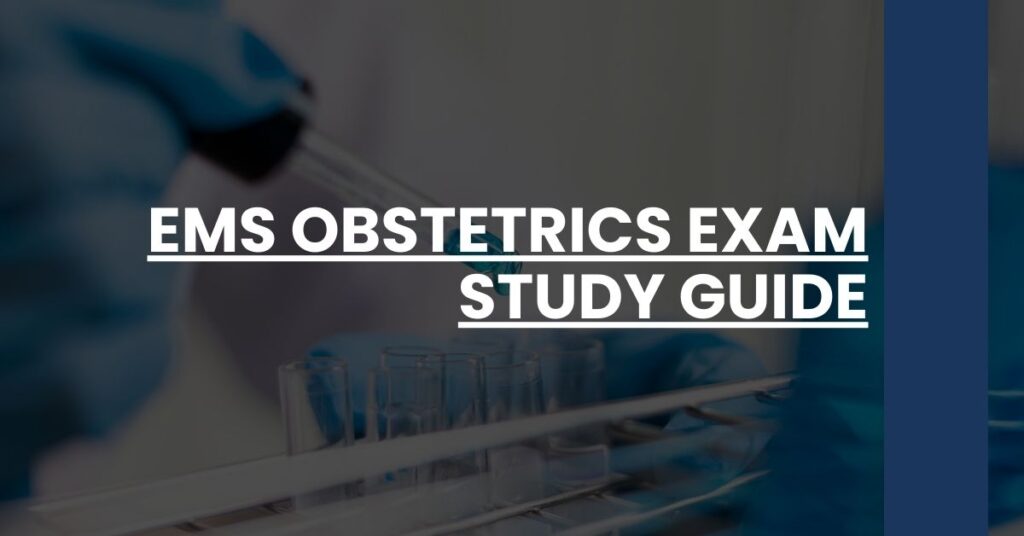Master your preparation with the EMS Obstetrics Exam Study Guide, tailored for first responders.
- Essential Knowledge: Equip yourself with vital understanding of maternal and neonatal care.
- Targeted Strategies: Learn how to tackle exam topics with precision.
- Resource Compilation: Access a curated list of materials for optimal exam readiness.
Your path to success begins with this EMS Obstetrics Exam Study Guide.
- Understanding the EMS Obstetrics Exam Scope
- Core Concepts in EMS Obstetrics
- Preparation Strategies for Success
- Key EMS Obstetrics Protocols
- Studying Maternal and Fetal Assessment
- Managing Obstetric Complications
- Neonatal Resuscitation and Care
- Simulation and Practical Training Resources
- Reviewing Case Studies and Scenarios
- Utilizing Online and Offline Study Resources
- Test-Taking Tips and Techniques
- Staying Updated with EMS Obstetrics Guidelines
- Conclusion: Ready for the EMS Obstetrics Challenge
Understanding the EMS Obstetrics Exam Scope
When embarking on your journey to conquer the EMS Obstetrics exam, it’s crucial to first lay out the battleground. This is not just any test; it’s a gauntlet that challenges your knowledge and ability to make swift decisions in maternal and neonatal emergencies.
What’s Covered?
This section of your EMS certification exam will test you on several vital areas:
- Pregnancy Physiology: It’s all about understanding the changes a mother’s body undergoes.
- Labor and Delivery: Recognizing the stages and knowing the drill for each phase is key.
- Neonatal Care: Once the baby has arrived, your actions within the first few minutes are pivotal.
- Obstetric Complications: From pre-eclampsia to hemorrhage, you need to have your game plan ready.
By familiarizing yourself with these topics, you will be better prepared to tackle this segment of your exam confidently.
Core Concepts in EMS Obstetrics
Grasping the core concepts in EMS Obstetrics is akin to building a rock-solid foundation for a house. Every piece of information serves as a block in constructing your ability to handle obstetric situations with poise and proficiency.
Anatomy and Physiology
Understanding the anatomy and physiological changes during pregnancy is more than memorizing textbook diagrams:
- Maternal Changes: You’ll need to know how a mother’s body adapts to nurture the growing fetus, from cardiovascular adjustments to the endocrine symphony in play.
- Fetal Development: Track the fetal journey from conception to birth, appreciating the critical milestones along the way.
Stages of Labor
Labor is a marathon, not a sprint. Recognize the signposts:
- Early Labor: Identifying its onset can dictate the initial course of action.
- Active Labor: Understanding what interventions are necessary and when.
- Delivery and Immediate Postpartum: The baby’s grand entrance and ensuring both mother and child are stable immediately after.
Recognizing Complications
When complications arise, your quick identification and response can make all the difference:
- Pre-delivery Emergencies: Conditions like placenta previa or abruptio placenta require immediate recognition.
- Postpartum Issues: For situations such as postpartum hemorrhage, having a systematic approach is imperative.
Preparation Strategies for Success
Mastering the EMS Obstetrics exam is no small feat, but with carefully crafted strategies, your journey can be a triumph.
Plan and Manage Your Time
It’s not simply about studying hard; it’s about studying smart:
- Set a Schedule: Allocate specific times for study sessions and stick to them.
- Prioritize Topics: Focus on areas where you feel least confident first.
- Take Breaks: Regular intervals of rest can actually enhance your memory retention.
Embrace Diverse Learning Techniques
- Visual Aids: Charts and diagrams can help you visualize complex processes.
- Audio Resources: Listen to lectures and podcasts for a different take on the material.
Education isn’t one-size-fits-all; find what happens to resonate with your learning style the best.
Key EMS Obstetrics Protocols
Having a grasp on the standard EMS protocols for obstetrical emergencies is like knowing the rules of the game. You play better when you know the playbook.
Pre-Delivery Emergencies
Prepping yourself on protocols means you won’t get sidelined by surprising situations:
- Breech Births: Have a game plan for when the baby is literally coming out feet first.
- Cord Prolapse: Understand the steps to take when the umbilical cord decides to jump the queue.
Childbirth and Postpartum Care
- Normal Deliveries: Even a standard delivery requires a meticulous adherence to protocols for the wellbeing of mother and child.
- Postpartum Complications: Grasp the guidelines for managing issues like retained placenta and perineal tears to effectively mitigate risks post-delivery.
Studying Maternal and Fetal Assessment
Success in the EMS Obstetrics exam often requires you to be a detective; you need to deduce the wellbeing of mother and baby from a handful of clues.
Evaluating Maternal Well-Being
- Vital Signs: Learn to read the story behind each number.
- Signs of Distress: Being able to pick up on subtle signals that suggest complications is a crucial skill.
Interpreting Fetal Monitoring
- Heart Rate Patterns: These can whisper hints about fetal distress or wellbeing.
- In-Utero Assessments: Understanding ultrasound and palpation findings can put you ahead of potential issues.
The more adept you become at assessment, the more you’ll excel in both the exam room and the field.
Managing Obstetric Complications
Developing proficiency in managing obstetric complications matters immensely; these are the moments when your knowledge meets the crucible of real-life emergencies.
Grasping Preeclampsia and Eclampsia
Knowing the warning signs and management steps for conditions like preeclampsia is non-negotiable. It’s about:
- Prompt Recognition: Catch the symptoms early to prevent a downward spiral.
- Immediate Management: Understand how to stabilize the patient until you can deliver her to definitive care.
Addressing Obstetric Hemorrhage
Bleeding during and after birth can turn a wonderous event into a crisis moment:
- Risk Factor Identification: Know who is more likely to experience hemorrhage.
- Stepwise Interventions: Follow evidence-based protocols to effectively manage and control bleeding.
These complications are serious, but with your preparation, they’ll be handled with professional ease.
Neonatal Resuscitation and Care
Minutes after birth are a critical period in an emergency medical situation. Your expertise in neonatal resuscitation and care ensures the best start to life for the newborn.
The First Golden Minute
In neonatal resuscitation, every second counts. You’ll need to know how to rapidly assess and act within the first minute after birth — often referred to as the “golden minute.”
- Initial Assessment: Quickly evaluate the baby’s breathing, color, and activity.
- Stimulation: Simple actions like drying and rubbing can encourage the infant’s first breath.
The Role of APGAR
The APGAR score, a test developed by Dr. Virginia Apgar, is an essential assessment tool for newborns. It’s crucial that you understand not just how to perform it, but also how to interpret the results.
- Appearance, Pulse, Grimace, Activity, and Respiration: These five criteria offer critical insights into the baby’s condition.
- Timing of Assessment: Conducting the APGAR at one and five minutes post-delivery provides key benchmarks of neonatal wellbeing.
Implementing Neonatal Resuscitation Program (NRP) Guidelines
Guided by the latest NRP algorithms, your resuscitation efforts include:
- Establishing an Airway: Position, clear, and, if necessary, suction the airway to facilitate breathing.
- Effective Ventilation: Start with positive pressure ventilation if the newborn is not breathing well on its own.
- Chest Compressions: If the heart rate remains too low, provide coordinated chest compressions.
Simulation and Practical Training Resources
Experiential learning through simulation and hands-on training is invaluable when preparing for the EMS Obstetrics exam and real-world emergencies.
Get Hands-On Experience
Practical skills are honed not just by reading but by doing. Engaging in workshops or simulations can give you the hands-on practice that will instill confidence and muscle memory.
- Simulated Scenarios: Participate in simulations that mimic real-world obstetric and neonatal emergencies.
- Skills Stations: Use manikins to practice processes like cord clamping, newborn assessment, and resuscitation techniques.
The Power of Feedback
In these training sessions, immediate feedback is not just helpful, it’s essential for improving and perfecting your technique.
- Constructive Criticism: Learn from instructors who can point out subtle mistakes or practices to improve upon.
- Peer Review: Working with fellow EMS providers can allow you to observe, critique, and learn from each other.
Reviewing Case Studies and Scenarios
Analyzing real-life case studies and scenarios offers a deep dive into the practical application of your book knowledge.
Learn From Real Events
The richness of details in a case study can offer insights into critical decision-making during obstetric emergencies.
- Critical Thinking: Develop your ability to think quickly and critically by reviewing the choices made in each case.
- Outcome Analysis: Understand the consequences of actions taken in real-world scenarios, which can significantly enhance your learning.
Scenario Exploration
Familiarize yourself with a spectrum of potential situations you might encounter through scenario-based learning.
- Variety of Complications: From routine deliveries to high-risk situations, the more scenarios you examine, the better prepared you’ll be.
- Interactive Learning: Actively engaging in discussing and breaking down each case can solidify your understanding and recall ability.
Utilizing Online and Offline Study Resources
A wealth of resources is available to guide your studies for the EMS Obstetrics exam. Whether online or offline, ensure you’re employing the right tools to facilitate your success.
Comprehensive Textbooks
Reach for textbooks that have stood the test of time in EMS education.
- Guideline Compatibility: Select materials that reflect the most current practice guidelines.
- Depth of Topics: Choose books that offer comprehensive coverage of obstetrics and neonatal care in emergency medicine.
Online Platforms
Leverage technology for a versatile and interactive study experience.
- Mobile Apps: Quick quizzes and flashcards can be powerful tools for on-the-go review.
- Video Tutorials: Visual learners can benefit significantly from step-by-step instructions on procedures and assessments.
Test-Taking Tips and Techniques
The art of test-taking is one you can master. Approach your EMS Obstetrics exam with strategies that can significantly enhance your performance.
Understand the Format
Be comfortable with the structure of your exam.
- Multiple-choice Mastery: Hone your skills in eliminating unlikely options to improve your chances of selecting the correct answer.
- Simulated Tests: Use practice exams to familiarize yourself with the timing and pace of the real test.
Approach Each Question Strategically
Tackle each question methodically.
- Careful Reading: Ensure you understand what the question is asking; sometimes the difference between options can be subtle.
- Informed Guessing: When in doubt, use your knowledge to make an educated guess rather than leaving an answer blank.
Staying Updated with EMS Obstetrics Guidelines
Medicine is ever-evolving, and staying informed about the latest guidelines and research in obstetrics is not just helpful for certification exams but is crucial for practice.
Follow Authoritative Sources
Ensure that the protocols you’re studying are the most current.
- Regular Updates: Subscribe to updates from major EMS and obstetrics organizations to stay informed.
- Continuing Education: Engaging in continuing education courses can help you keep up with the latest evidence-based practices.
Engage With the Community
Join forums and discussions with other EMS professionals.
- Shared Knowledge: Gain insights from the experiences and knowledge of your peers.
- New Developments: Learn about new techniques and equipment that are on the forefront of obstetric emergency care.
Conclusion: Ready for the EMS Obstetrics Challenge
You’ve equipped yourself with a comprehensive EMS Obstetrics exam study guide, tailored to help you navigate the complexities of maternal and neonatal emergencies with confidence. Every piece of preparation you engage in brings you one step closer to not just passing your exam but becoming a more proficient and knowledgeable EMS professional. So dive into your studies, harness every resource at your disposal, and remember that every lesson learned could be the key to saving lives. Your dedication to mastering these critical skills makes you an invaluable asset to any emergency team – and to every expecting family you assist.
EMS Obstetrics Exam Study Guide: Master maternal and neonatal emergency protocols for EMT certification success. Essential tips and resources.

